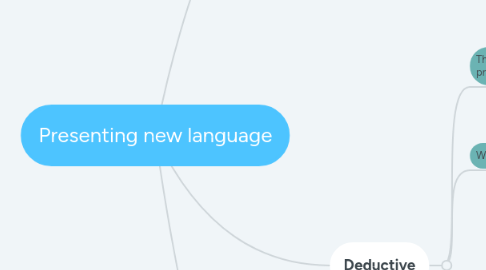
1. Inductive
1.1. The process of 'discovering' general principles from facts.
1.1.1. Modern way of teaching
1.2. What does the approach look like?
1.2.1. Example
1.2.1.1. The teacher gives the learners a text to read and respond to.
1.2.1.2. The learners themselves suggest headings for these categories.
1.3. Why use the inductive approach?
1.3.1. Treat the student as knowledge discoverers
1.3.2. It moves the focus away from rules to use – and use is, after all, our aim in teaching.
1.3.3. Can exploit authentic material from a wide range of sources to present our target language.
1.4. Disadvantage/ Advantage
1.4.1. thanks independent learning
1.4.2. requires more time for learning
1.4.3. non-retail education
2. Deductive
2.1. The process of applying general principles to use.
2.1.1. Traditional way of teaching
2.2. What does the approach look like?
2.2.1. Example
2.2.1.1. The teacher then presents the new language by describing what these people have been doing.
2.2.1.2. The learners listen and then repeat the language. The teacher then explains the structure, how it works, and how it is made.
2.3. Why use the deductive approach?
2.3.1. Can control the level of input language more.
2.3.2. Can control our learners’ understanding of rules more – making sure that the ideas they form about language are the right ones. In this way can try to avoid learners forming incorrect hypotheses.
2.4. disadvantage/Advantage
2.4.1. Disconnected from the real world
2.4.2. Not motivating
2.4.3. Teacher dependent learning
2.4.4. Monorist learning
